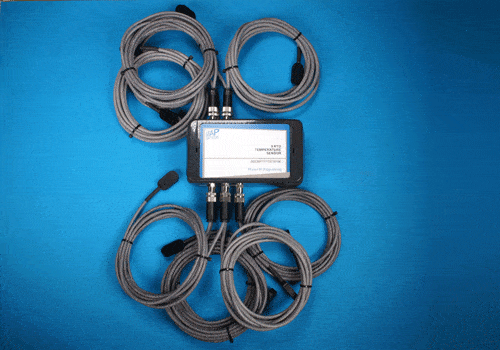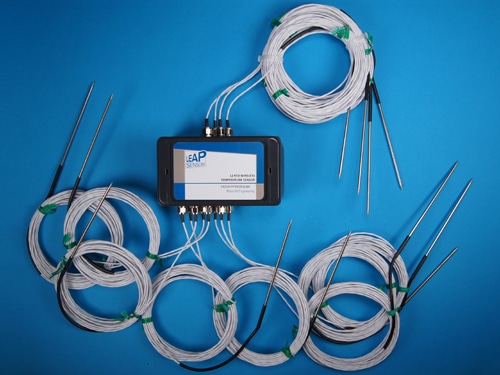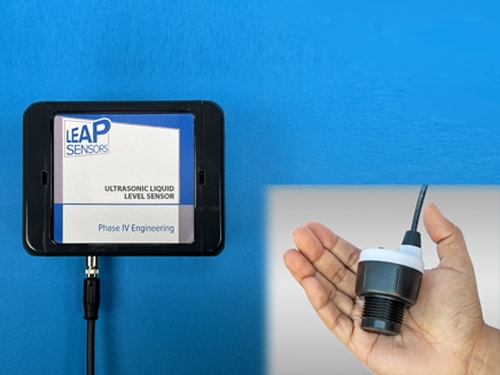-
 Get instantaneous flow rate information without cutting into pipes and running signal wires. The Leap Sensors wireless transceiver node can integrate with a wide range of ultrasonic and Doppler clamp-on flow meters. Connect to plant software with the Modbus interface or use Leap's cloud-based software. Due to the large power consumption of ultrasonic and Doppler flow meters, the flow meter must be powered by 120V. Data from the flow meter is sent wirelessly via a gateway to the software. Clamp-on flow meters are available for a wide range of pipe sizes from 0.5 to 48 inches. Use for metal or plastic pipes. Contact us to find the best clamp-on flow sensor for your application. Part of the breakthrough Leap Sensors® system. Build your quote here:
Get instantaneous flow rate information without cutting into pipes and running signal wires. The Leap Sensors wireless transceiver node can integrate with a wide range of ultrasonic and Doppler clamp-on flow meters. Connect to plant software with the Modbus interface or use Leap's cloud-based software. Due to the large power consumption of ultrasonic and Doppler flow meters, the flow meter must be powered by 120V. Data from the flow meter is sent wirelessly via a gateway to the software. Clamp-on flow meters are available for a wide range of pipe sizes from 0.5 to 48 inches. Use for metal or plastic pipes. Contact us to find the best clamp-on flow sensor for your application. Part of the breakthrough Leap Sensors® system. Build your quote here: -
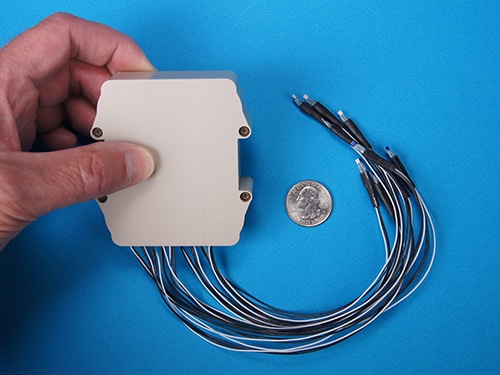 This specially-designed wireless temperature sensor has 9 precision RTDs. The entire transceiver node can operate up to 250ºC (482ºF) - the highest-temperature-rated enclosure we offer. The node is less than 1 inch (2.5 cm) thick - able to ride on a wafer or circuit board through a reflow oven. For wafer temperature monitoring, RTD sensors are ultra-thin and small for a fast response to temperature changes. For other applications, virtually any other RTD sensor can be integrated, including pointed insertion probes for meat or food processing. 3-wire configuration on RTDs assures extra accuracy and immunity to the high-temperature environments. Sensor cable lengths can be made to order. Part of the breakthrough Leap Sensors® system. Build your quote here:
This specially-designed wireless temperature sensor has 9 precision RTDs. The entire transceiver node can operate up to 250ºC (482ºF) - the highest-temperature-rated enclosure we offer. The node is less than 1 inch (2.5 cm) thick - able to ride on a wafer or circuit board through a reflow oven. For wafer temperature monitoring, RTD sensors are ultra-thin and small for a fast response to temperature changes. For other applications, virtually any other RTD sensor can be integrated, including pointed insertion probes for meat or food processing. 3-wire configuration on RTDs assures extra accuracy and immunity to the high-temperature environments. Sensor cable lengths can be made to order. Part of the breakthrough Leap Sensors® system. Build your quote here: -
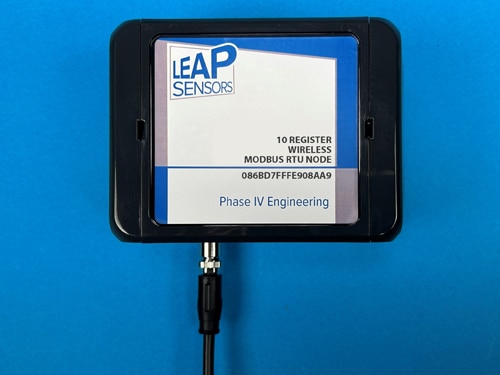 Wireless transceiver node with an RS485 Modbus RTU interface can read up to 10 Modbus registers to track valuable machine monitoring data. Can be used with almost any Modbus RTU sensor and communication device. Contact us to discuss best options for your application. Connect the transceiver node to a variable frequency drive (VFD) to collect data such as electric current draw, voltage levels, RPM, temperatures, and error conditions. Ideal for predictive maintenance or automated process auditing. Due to the high-power consumption of the Modbus RTU interface, this transceiver node typically uses a external power source to power the node. Battery power is an option if data sampling and transmitting is done every few hours. Part of the breakthrough Leap Sensors® system. Build your quote here:
Wireless transceiver node with an RS485 Modbus RTU interface can read up to 10 Modbus registers to track valuable machine monitoring data. Can be used with almost any Modbus RTU sensor and communication device. Contact us to discuss best options for your application. Connect the transceiver node to a variable frequency drive (VFD) to collect data such as electric current draw, voltage levels, RPM, temperatures, and error conditions. Ideal for predictive maintenance or automated process auditing. Due to the high-power consumption of the Modbus RTU interface, this transceiver node typically uses a external power source to power the node. Battery power is an option if data sampling and transmitting is done every few hours. Part of the breakthrough Leap Sensors® system. Build your quote here: -
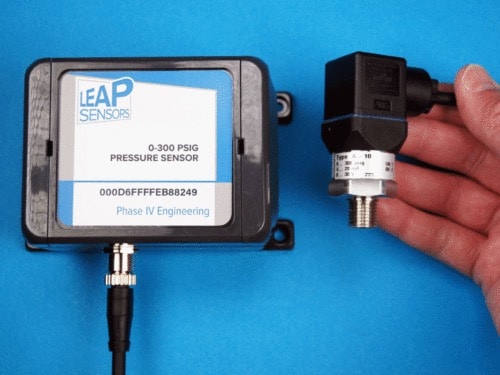 The Leap wireless pressure transceiver can integrate with every type of WIKA pressure transducer - 4-20mA, 0-10V, and I2C outputs.
The Leap wireless pressure transceiver can integrate with every type of WIKA pressure transducer - 4-20mA, 0-10V, and I2C outputs.Configured to Your Exact Application
The external industrial sensor may be powered by an optional 12 or 24V power supply driven from the over-sized Leap Sensor node battery. No external power source is needed with the 12/24V power supply option (LP-1PXX). See below for other options to configure this industrial wireless sensor node to your exact needs. Contact us to find the best combination or let us know which WIKA sensor you would like us to integrate. See the data sheet for detailed specifications. Part of the breakthrough Leap Sensors® system. Build your quote here: -
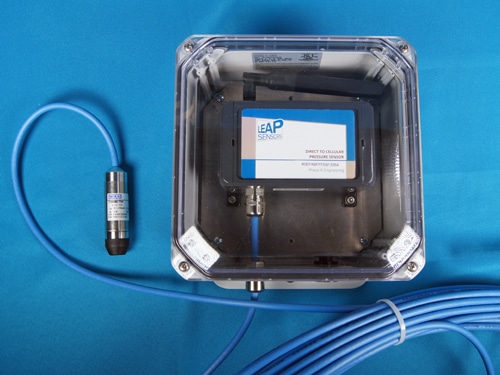 This unique wireless sensor remotely measures the depth of a liquid in a tank or pond using a submersible pressure sensor. The Leap Sensor transceiver node uses edge computing to convert the pressure measurement to liquid depth. Completely battery-powered - no external power source needed. Optional water- and weather-proof enclosure protects the sensor transceiver node. Optional direct-to-cellular technology for remote locations. Data is sent directly to a cloud server. Contact us for the best combination of pressure sensor and other options for your application. Part of the breakthrough Leap Sensors® system. Build your quote here:
This unique wireless sensor remotely measures the depth of a liquid in a tank or pond using a submersible pressure sensor. The Leap Sensor transceiver node uses edge computing to convert the pressure measurement to liquid depth. Completely battery-powered - no external power source needed. Optional water- and weather-proof enclosure protects the sensor transceiver node. Optional direct-to-cellular technology for remote locations. Data is sent directly to a cloud server. Contact us for the best combination of pressure sensor and other options for your application. Part of the breakthrough Leap Sensors® system. Build your quote here: -
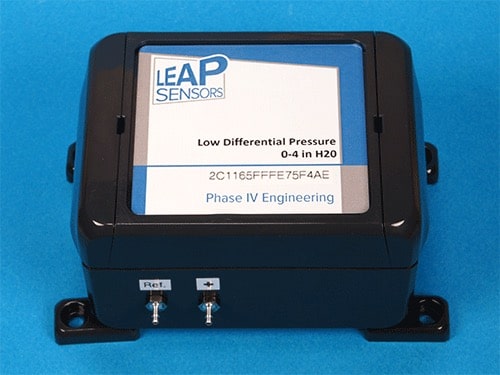 Wireless differential pressure gauge monitors at low pressure levels. This powerful sensor can be used alongside or as a replacement for magnehelic gauges when continuous remote equipment monitoring and alerts are needed. Ideal for monitoring HVAC filters, exhaust blowers, and differential pressure across clean rooms. Standard pressure ranges are: 0.15 PSID (-1P01) and 1.0 PSID (-1P07). Contact us for 0.3 PSID (-1P06, longer lead time). Build your quote here:
Wireless differential pressure gauge monitors at low pressure levels. This powerful sensor can be used alongside or as a replacement for magnehelic gauges when continuous remote equipment monitoring and alerts are needed. Ideal for monitoring HVAC filters, exhaust blowers, and differential pressure across clean rooms. Standard pressure ranges are: 0.15 PSID (-1P01) and 1.0 PSID (-1P07). Contact us for 0.3 PSID (-1P06, longer lead time). Build your quote here: -
 The Leap wireless pressure transceiver can integrate with every type differential pressure switch with a "dry contact" switch output. The differential pressure switch featured with this product is a Cleveland Controls Air Sensing Switch, HVAC/General Purpose Type, 0.02 to 0.8 Differential (In. WC). Contact us to find the best combination or let us know which pressure switch you would like us to integrate. Part of the breakthrough Leap Sensors® system. Build your quote here:
The Leap wireless pressure transceiver can integrate with every type differential pressure switch with a "dry contact" switch output. The differential pressure switch featured with this product is a Cleveland Controls Air Sensing Switch, HVAC/General Purpose Type, 0.02 to 0.8 Differential (In. WC). Contact us to find the best combination or let us know which pressure switch you would like us to integrate. Part of the breakthrough Leap Sensors® system. Build your quote here: -
 This very unique wireless sensor works by comparing the readings from one device node to another user-selected device node - then reporting the local pressure, local temperature - then differential pressure and temperature as compared to a user selected sensor. For example, sensor A is located outside at ambient temperature and pressure. Sensor B is located in a clean room under positive pressure and Sensor C is located in a different part of the cleanroom under a higher positive pressure. Sensor B could be configured to report its pressure and temperature and the differential pressure between Sensor B and Sensor A. (See the screen shot). Sensor C could be configured to report its pressure and temperature and the differential pressure and temperature between sensor C and sensor B. Sensor readings are reported in PSIA. Leverage the Leap SensorManager software to send text, email, or telephone alerts when a pressure, temperature, or delta-pressure or delta-temperature threshold is exceeded. Integrate the data from the differential pressure sensors into other software using our web-based API, Modbus, DNP3, or other data interface protocols. The wireless sensor can be configured with pressure sensors that have different ranges, resolutions, and accuracies for different applications. See the specification below for more information on the different options. Pressure sensors can be configured to specific applications. The pressure and temperature sensors in the photos have the pressure and temperature sensor sealed inside the enclosure with a pressure port in the back of the enclosure. Part of the breakthrough Leap Sensors® system. Build your quote here:
This very unique wireless sensor works by comparing the readings from one device node to another user-selected device node - then reporting the local pressure, local temperature - then differential pressure and temperature as compared to a user selected sensor. For example, sensor A is located outside at ambient temperature and pressure. Sensor B is located in a clean room under positive pressure and Sensor C is located in a different part of the cleanroom under a higher positive pressure. Sensor B could be configured to report its pressure and temperature and the differential pressure between Sensor B and Sensor A. (See the screen shot). Sensor C could be configured to report its pressure and temperature and the differential pressure and temperature between sensor C and sensor B. Sensor readings are reported in PSIA. Leverage the Leap SensorManager software to send text, email, or telephone alerts when a pressure, temperature, or delta-pressure or delta-temperature threshold is exceeded. Integrate the data from the differential pressure sensors into other software using our web-based API, Modbus, DNP3, or other data interface protocols. The wireless sensor can be configured with pressure sensors that have different ranges, resolutions, and accuracies for different applications. See the specification below for more information on the different options. Pressure sensors can be configured to specific applications. The pressure and temperature sensors in the photos have the pressure and temperature sensor sealed inside the enclosure with a pressure port in the back of the enclosure. Part of the breakthrough Leap Sensors® system. Build your quote here:
